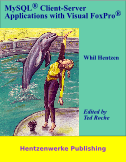One of my current client projects requires me to VPN into their establishment. Rather than have a second machine running Windows, I thought I’d try running VMWare using a dual-boot (WinXPPro/Fedora Core 6) machine. A recent Linux Magazine article by Jason Perlow, “Run Your Windows with VMWare” pointed out that VMWare can read a Windows installation off disk and run it as if it were a virtual image, a feature I wasn’t aware of. You get the benefits of both having a VM and being able to dual-boot. Cool! So, I set about the process of installing such beast.
VMWare offers several versions for free (as in price, not as in speech) downloads. Their main install scripts (written in Perl) are pretty slick, detecting problems, coaching you for the correct actions, and advising about where more information can be found. Several cycles of script, run, error, re-configure, install, repeat got me to a working VMWare install. Extra clues were found in “How to Install VMWare Server on A Fedora Core 6 Desktop” and “Run Existing Windows Installation with VMWare Player.” Some obscure permission errors (VMWare reports that it can’t open the image or some related file) were fixed by adding my login to the ‘disk’ group so VMWare could read the raw disk, and giving the /dev/hda device group-read-write access (sudo chmod g+rw /dev/hda – there’s a way to do this permanently…). I confirmed VMWare was installed correctly by downloading and running one of the many VMs that can be found at the VMWare Virtual Appliance Marketplace. After a few tweaks to the settings in the Windows-from-disk virtual machine configuration file windows.vmdk and generating a separate file for the MBR from the disk, booting into the VM produced by startup GRUB menu! Selecting a Linux partition started Linux, but selecting the Windows partition just hung after the message “chainloader +1”.
It’s progress. Now to Google around and see what the next tweak needs to be…
 Followers of the Hentzenwerke Publishing empire know that Whil Hentzen has the largest catalog of Visual FoxPro books and an impressive collection of books bridging the gap from the Windows world into the Linux/Free/Open Source world. Whil’s been working for quite some time to put together a book on working with VFP and back-end data servers other than SQL Server. I was one of the many community members who contributed comments, criticisms and ideas to the book, and was honored when Whil chose to designate me as technical editor. Whil Hentzen announces,
Followers of the Hentzenwerke Publishing empire know that Whil Hentzen has the largest catalog of Visual FoxPro books and an impressive collection of books bridging the gap from the Windows world into the Linux/Free/Open Source world. Whil’s been working for quite some time to put together a book on working with VFP and back-end data servers other than SQL Server. I was one of the many community members who contributed comments, criticisms and ideas to the book, and was honored when Whil chose to designate me as technical editor. Whil Hentzen announces,